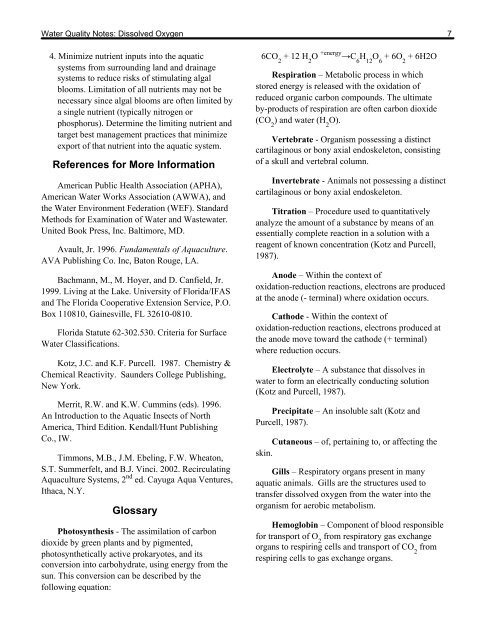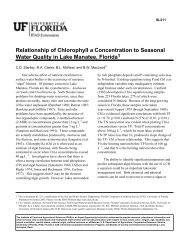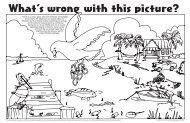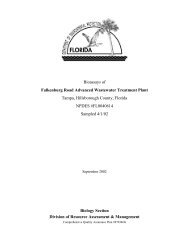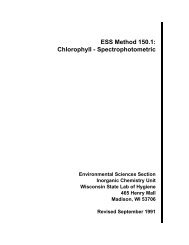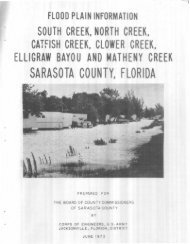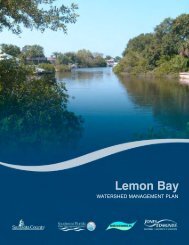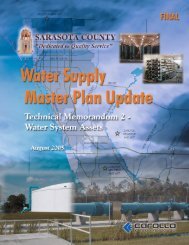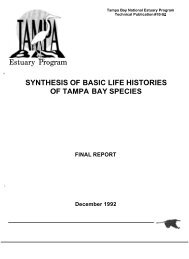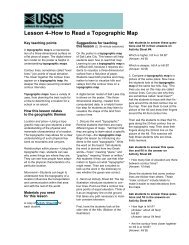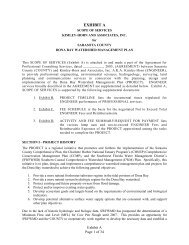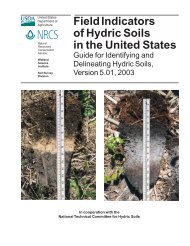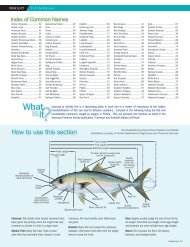Water Quality Notes: Dissolved Oxygen1 - Polk.WaterAtlas.org
Water Quality Notes: Dissolved Oxygen1 - Polk.WaterAtlas.org
Water Quality Notes: Dissolved Oxygen1 - Polk.WaterAtlas.org
Create successful ePaper yourself
Turn your PDF publications into a flip-book with our unique Google optimized e-Paper software.
<strong>Water</strong> <strong>Quality</strong> <strong>Notes</strong>: <strong>Dissolved</strong> Oxygen 74. Minimize nutrient inputs into the aquaticsystems from surrounding land and drainagesystems to reduce risks of stimulating algalblooms. Limitation of all nutrients may not benecessary since algal blooms are often limited bya single nutrient (typically nitrogen orphosphorus). Determine the limiting nutrient andtarget best management practices that minimizeexport of that nutrient into the aquatic system.References for More InformationAmerican Public Health Association (APHA),American <strong>Water</strong> Works Association (AWWA), andthe <strong>Water</strong> Environment Federation (WEF). StandardMethods for Examination of <strong>Water</strong> and Wastewater.United Book Press, Inc. Baltimore, MD.Avault, Jr. 1996. Fundamentals of Aquaculture.AVA Publishing Co. Inc, Baton Rouge, LA.Bachmann, M., M. Hoyer, and D. Canfield, Jr.1999. Living at the Lake. University of Florida/IFASand The Florida Cooperative Extension Service, P.O.Box 110810, Gainesville, FL 32610-0810.Florida Statute 62-302.530. Criteria for Surface<strong>Water</strong> Classifications.Kotz, J.C. and K.F. Purcell. 1987. Chemistry &Chemical Reactivity. Saunders College Publishing,New York.Merrit, R.W. and K.W. Cummins (eds). 1996.An Introduction to the Aquatic Insects of NorthAmerica, Third Edition. Kendall/Hunt PublishingCo., IW.Timmons, M.B., J.M. Ebeling, F.W. Wheaton,S.T. Summerfelt, and B.J. Vinci. 2002. RecirculatingAquaculture Systems, 2 nd ed. Cayuga Aqua Ventures,Ithaca, N.Y.GlossaryPhotosynthesis - The assimilation of carbondioxide by green plants and by pigmented,photosynthetically active prokaryotes, and itsconversion into carbohydrate, using energy from thesun. This conversion can be described by thefollowing equation:6CO + 12 H O +energy →C H O + 6O + 6H2O2 26 12 6 2Respiration – Metabolic process in whichstored energy is released with the oxidation ofreduced <strong>org</strong>anic carbon compounds. The ultimateby-products of respiration are often carbon dioxide(CO 2) and water (H 2O).Vertebrate - Organism possessing a distinctcartilaginous or bony axial endoskeleton, consistingof a skull and vertebral column.Invertebrate - Animals not possessing a distinctcartilaginous or bony axial endoskeleton.Titration – Procedure used to quantitativelyanalyze the amount of a substance by means of anessentially complete reaction in a solution with areagent of known concentration (Kotz and Purcell,1987).Anode – Within the context ofoxidation-reduction reactions, electrons are producedat the anode (- terminal) where oxidation occurs.Cathode - Within the context ofoxidation-reduction reactions, electrons produced atthe anode move toward the cathode (+ terminal)where reduction occurs.Electrolyte – A substance that dissolves inwater to form an electrically conducting solution(Kotz and Purcell, 1987).Precipitate – An insoluble salt (Kotz andPurcell, 1987).Cutaneous – of, pertaining to, or affecting theskin.Gills – Respiratory <strong>org</strong>ans present in manyaquatic animals. Gills are the structures used totransfer dissolved oxygen from the water into the<strong>org</strong>anism for aerobic metabolism.Hemoglobin – Component of blood responsiblefor transport of O 2from respiratory gas exchange<strong>org</strong>ans to respiring cells and transport of CO 2fromrespiring cells to gas exchange <strong>org</strong>ans.


